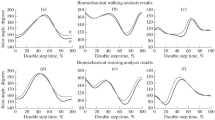Abstract
When leaping an obstacle, the runner increases the vertical velocity of his/her centre of mass (COM) at takeoff to augment the amplitude and duration of the aerial phase over it. This study analyses the modification of the bouncing mechanism of running when approaching a barrier. The forces exerted by the feet on the ground are measured by a 13-m-long force platform during the four to nine running steps preceding the jump over a 0.45- to 0.85-m-high barrier, at an approaching speed between 9 and 21 km h−1. The movements of the COM are evaluated by time-integration of the forces and the stiffness of the bouncing system by computer simulation. The running mechanism is modified during the two steps preceding the barrier. During the contact period, two steps before the barrier, the leg-spring stiffness decreases; consequently, the COM is lowered and accelerated forward. Then during the contact period preceding the obstacle, the leg-spring stiffness increases and the COM is raised and accelerated upwards, whereas its forward velocity is reduced. During this phase, the leg-spring acts like a pole, which stores elastic energy and changes the direction of the velocity vector to release this energy in a vertical direction. At high speeds, this storage–release mechanism of elastic energy is sufficient to provide the energy necessary to leap the obstacle. On the contrary, at low speeds, the amount of elastic energy stored and released in the leg-spring is not sufficient to jump over the obstacle and additional positive muscular work must be done.









Similar content being viewed by others
References
Alexander RM (1992) A model of bipedal locomotion on compliant legs. Philos Trans R Soc Lond B Biol Sci 338(1284):189–198. doi:10.1098/rstb.1992.0138
Begg RK, Sparrow WA, Lythgo ND (1998) Time–domain analysis of foot-ground reaction forces in negotiating obstacles. Gait Posture 7(2):99–109
Blickhan R (1989) The spring–mass model for running and hopping. J Biomech 22(11–12):1217–1227. doi:0021-9290(89)90224-8
Cavagna GA (1975) Force platforms as ergometers. J Appl Physiol 39(1):174–179
Cavagna GA, Dusman B, Margaria R (1968) Positive work done by a previously stretched muscle. J Appl Physiol 24(1):21–32
Cavagna GA, Komarek L, Mazzoleni S (1971) The mechanics of sprint running. J Physiol 217(3):709–721
Cavagna GA, Thys H, Zamboni A (1976) The sources of external work in level walking and running. J Physiol 262(3):639–657
Cavagna GA, Franzetti P, Heglund NC, Willems P (1988) The determinants of the step frequency in running, trotting and hopping in man and other vertebrates. J Physiol 399:81–92
Cavagna GA, Willems PA, Franzetti P, Detrembleur C (1991) The two power limits conditioning step frequency in human running. J Physiol 437:95–108
Cavagna GA, Heglund NC, Willems PA (2005) Effect of an increase in gravity on the power output and the rebound of the body in human running. J Exp Biol 208(Pt 12):2333–2346. doi:10.1242/jeb.01661
Farley CT, Gonzalez O (1996) Leg stiffness and stride frequency in human running. J Biomech 29(2):181–186
Farley CT, Morgenroth DC (1999) Leg stiffness primarily depends on ankle stiffness during human hopping. J Biomech 32(3):267–273
Farley CT, Glasheen J, McMahon TA (1993) Running springs: speed and animal size. J Exp Biol 185:71–86
Ferris DP, Louie M, Farley CT (1998) Running in the real world: adjusting leg stiffness for different surfaces. Proc Biol Sci 265(1400):989–994. doi:10.1098/rspb.1998.0388
Ferris DP, Liang K, Farley CT (1999) Runners adjust leg stiffness for their first step on a new running surface. J Biomech 32(8):787–794
Genin JJ, Willems PA, Cavagna GA, Lair R, Heglund NC (2010) Biomechanics of locomotion in Asian elephants. J Exp Biol 213(5):694–706. doi:10.1242/jeb.035436
He JP, Kram R, McMahon TA (1991) Mechanics of running under simulated low gravity. J Appl Physiol 71(3):863–870
Hill AV (1922) The maximum work and mechanical efficiency of human muscles, and their most economical speed. J Physiol 56(1–2):19–41
Lee DV, Bertram JEA, Anttonen JT, Ros IG, Harris SL, Biewener AA (2011) A collisional perspective on quadrupedal gait dynamics. J R Soc Interface. doi:10.1098/rsif.2011.0019
Linthorne NP (2000) Energy loss in the pole vault take-off and the advantage of the flexible pole. Sports Eng 3(4):205–218
McGowan CP, Grabowski AM, McDermott WJ, Herr HM, Kram R (2012) Leg stiffness of sprinters using running-specific prostheses. J R Soc Interface. doi:10.1098/rsif.2011.0877
McMahon TA, Cheng GC (1990) The mechanics of running: how does stiffness couple with speed? J Biomech 23(Suppl 1):65–78
McMahon TA, Valiant G, Frederick EC (1987) Groucho running. J Appl Physiol 62(6):2326–2337
Morin JB, Dalleau G, Kyrolainen H, Jeannin T, Belli A (2005) A simple method for measuring stiffness during running. J Appl Biomech 21(2):167–180
Roberts TJ, Marsh RL, Weyand PG, Taylor CR (1997) Muscular force in running turkeys: the economy of minimizing work. Science 275(5303):1113–1115
Roberts TJ, Kram R, Weyand PG, Taylor CR (1998) Energetics of bipedal running. I: metabolic cost of generating force. J Exp Biol 201(Pt 19):2745–2751
Schade F, Arampatzis A, Bruggemann GP (2006) Reproducibility of energy parameters in the pole vault. J Biomech 39(8):1464–1471. doi:10.1016/j.jbiomech.2005.03.027
Schepens B, Willems PA, Cavagna GA (1998) The mechanics of running in children. J Physiol 509(Pt 3):927–940
Sparrow WA, Shinkfield AJ, Chow S, Begg RK (1996) Characteristics of gait in stepping over obstacles. Hum Mov Sci 15(4):605–622
Willems PA, Cavagna GA, Heglund NC (1995) External, internal and total work in human locomotion. J Exp Biol 198(Pt 2):379–393
Acknowledgments
This study was funded by the Université catholique de Louvain.
Author information
Authors and Affiliations
Corresponding author
Additional information
Communicated by Jean-René Lacour.
Electronic supplementary material
Below is the link to the electronic Supplementary materials.
Rights and permissions
About this article
Cite this article
Mauroy, G., Schepens, B. & Willems, P.A. The mechanics of running while approaching and jumping over an obstacle. Eur J Appl Physiol 113, 1043–1057 (2013). https://doi.org/10.1007/s00421-012-2519-1
Received:
Accepted:
Published:
Issue Date:
DOI: https://doi.org/10.1007/s00421-012-2519-1




